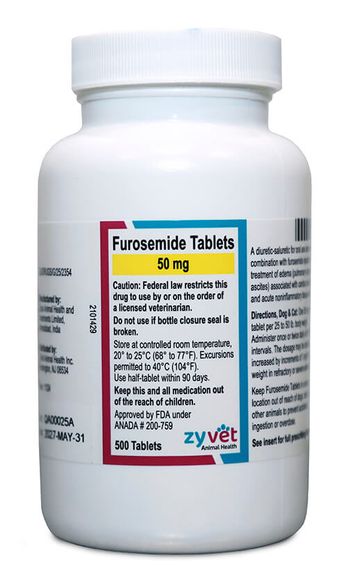
Toxicology case: Albuterol toxicosis in a pit bull terrier
Calming a pit bull's racing heart after exposure to this bronchodilator.
A 2-year-old 58.7-lb (26.5-kg) spayed female pit bull terrier was presented to an emergency clinic for evaluation of panting and what the owner suspected to be tachycardia, since the owner felt like the dog's heart was racing.
HISTORY
About five hours earlier, the owner had discovered an aerosol albuterol inhaler (90 µg/actuation) in the dog's crate with two punctures in it. The owner had used this inhaler only a couple of times. The dose of albuterol the dog was exposed to could not be determined.
The dog had a history of allergies and atopy. It was receiving prednisone every other day.
PHYSICAL EXAMINATION AND DIAGNOSTIC TESTS
At presentation, the dog was tachycardic with a heart rate of 220 bpm and was panting. Its body temperature was normal (100.4 F). The conjunctiva was hyperemic bilaterally, and its digits were erythematous. The patient had areas of multifocal alopecia (suspected to be secondary to allergies). Abnormal laboratory results included hypokalemia (serum potassium = 2.6 mmol/L; normal range = 3.4 to 4.9 mmol/L), hyperglycemia (serum glucose = 121 mg/dl; normal range = 60 to 115 mg/dl), metabolic acidosis (blood pH, venous = 7.304; normal range = 7.35 to 7.45), and base excess (-8; normal range = -5 to 0).
TREATMENT
The dog was admitted to the hospital for treatment of tachycardia, electrolyte concentration monitoring, and supportive care. Plasma-Lyte (Baxter) intravenous fluids, supplemented with 40 mEq/L of potassium chloride, were administered at 90 ml/hr, and 10 mg of propranolol (0.37 mg/kg) was given orally since the intravenous form was not available. The patient's heart rate, blood pressure, and electrolyte concentrations, including serum potassium and phosphorus, were monitored over the next 18 hours.
Within two hours of giving the propranolol, the dog's heart rate was approximately 160 bpm and then remained 150 bpm or less for the duration of hospitalization. The panting resolved within two hours of initiating treatment, and the conjunctival hyperemia resolved as well.
Within five hours of presentation, the acidosis had resolved, but the patient's potassium concentration was still slightly low (3.3 mmol/L). Within nine hours of presentation, the serum potassium concentration was normal (4.2 mmol/L). The potassium chloride supplementation within the Plasma-Lyte was then changed to 20 mEq/L. The dog's blood pressure and electrocardiogram (ECG) remained normal throughout hospitalization.
The patient was discharged 18 hours after being admitted to the hospital.
DISCUSSION
Albuterol toxicosis is common in dogs because dogs tend to chew on albuterol-containing inhalers and the liquid vials used in nebulizers. Since 2002, the ASPCA Animal Poison Control Center (APCC) has received more than 4,000 calls about albuterol exposures. More than 95% of these calls involved dogs (ASPCA APCC Database: Unpublished data, 2002-2013).
Pathophysiology
Albuterol is a beta-adrenergic agonist used primarily in veterinary medicine as a bronchodilator in dogs, cats, and horses.1 Recommended doses in dogs range from 0.02 to 0.05 mg/kg orally every eight to 12 hours. For inhalation in a 60-lb dog, 0.5 ml of a 0.5% solution for nebulization mixed in 4 ml of saline can be nebulized every six hours.1
Beta-adrenergic receptors are divided into mainly two types: beta-1 and beta-2. Beta-1 receptors are found within the myocardium and control the heart rate and contractility. Beta-2 receptors are located primarily within the smooth muscles of the blood vessels, airways, gastrointestinal tract, and genitourinary system. There are also beta-2 receptors within the heart, liver, and skeletal muscles.2 These receptors are responsible for the relaxation of the uterine and bronchial smooth muscles and for vasodilation.3
Albuterol is a selective beta-2 receptor agonist. When used to treat bronchoconstriction, beta-adrenergic agonists bind to the beta-2 receptors located on the bronchial smooth muscle. This binding stimulates a conversion of adenosine triphosphate into cyclic adenosine monophosphate. Increased cyclic adenosine monophosphate causes bronchial muscle cells to relax, resulting in bronchodilation.4,5
Even with therapeutic doses, clinical effects may include transient hypotension, reflex tachycardia, and mild muscle tremors, in addition to the desired bronchodilation, because of multiple beta-2 receptor binding sites within the body.5 In overdose situations, the selectivity for beta-2 receptors is lost, and albuterol will stimulate both beta-1 and beta-2 receptors.
Clinical signs
Clinical signs associated with overstimulation of both beta-1 and beta-2 receptors, as well as catecholamine release, can include tachycardia, hypotension, hypertension, muscle tremors, vomiting, tachypnea, agitation, hyperactivity, arrhythmias (most commonly supraventricular tachycardia), lethargy, and weakness. This muscle weakness and lethargy could be secondary to hypokalemia or discomfort from the tachycardia and a result of poor cardiac output secondary to significant tachycardia, myocardial fatigue, or myocardial ischemia. Patients that do not receive prompt treatment for supraventricular tachycardia may be more likely to develop ventricular arrhythmias.
Hypokalemia may develop secondary to an intracellular shift of potassium and could contribute to arrhythmias seen in some patients. Hypophosphatemia may also be seen, and it is also thought to be from intracellular movement.2,5
Treatment and monitoring
Since the ventricular tachycardia in albuterol toxicosis occurs from the overstimulation of beta receptors, both beta-1 and beta-2 receptors are involved. Propranolol works well to treat these signs. Propranolol is a nonspecific beta-blocking agent, which means it can block both beta-1 and beta-2 receptors. Therapeutic doses range from 0.02 mg/kg slowly intravenously up to a maximum of 0.1 mg/kg in dogs and cats, 0.1 to 0.2 mg/kg orally in dogs up to a maximum of 1.5 mg/kg every eight hours, and 2.5 to 10 mg total in cats every eight to 12 hours.1
An alternative medication used to treat the clinical signs of albuterol toxicosis is esmolol. Esmolol is a specific beta-1 adrenergic blocker that is used to control ventricular arrhythmias. It can be administered to dogs as an initial slow intravenous bolus of 0.25 to 0.5 mg/kg over one or two minutes, followed by a constant rate infusion of 0.01 to 0.2 mg/kg/min.1
Monitoring serum electrolyte concentrations, especially potassium and phosphorus, is important because many patients exposed to albuterol develop hypokalemia and hypophosphatemia. Hypokalemia and hypophosphatemia likely occur secondary to intracellular shifts, so use caution to not oversupplement intravenous fluids with potassium chloride or phosphorous. If the potassium concentration is < 2.5 mEq/L, then supplementation with potassium chloride is needed. In my experience, the phosphorus concentration will often correct when the potassium concentration is corrected. Monitor electrolyte concentrations every four to six hours until they are normal.
Stimulatory signs such as tremors, hyperactivity, and agitation are often well-controlled with benzodiazepines such as diazepam (0.5 to 1 mg/kg intravenously) or midazolam (0.1 to 0.5 mg/kg intravenously).1 Signs of muscle weakness and lethargy often resolve once the patient's electrolyte concentrations and heart rate are regulated.
Administering activated charcoal is usually not practical after exposure to an albuterol inhaler or albuterol liquids because albuterol is absorbed rapidly and does not undergo enterohepatic recirculation. If an animal ingests albuterol-containing tablets and is asymptomatic, then induce emesis by administering 3% hydrogen peroxide (2.2 ml/kg orally, repeat once if emesis does not occur the first time) or apomorphine (into the conjunctival sac or intravenously [0.03 to 0.04 mg/kg]).1 Then follow that with the administration of activated charcoal (2 to 3 g/kg orally).
Monitoring these patients' ECGs is also recommended, as some animals can develop ventricular premature contractions. If ventricular premature contractions are seen, lidocaine can be given intravenously at 2 to 8 mg/kg slowly followed by a constant rate infusion of 25 to 75 µg/kg/min in dogs. Use caution when giving this medication to cats since it can result in seizures and cardiovascular changes. Therapeutic doses in this species are 0.25 to 0.5 mg/kg slowly intravenously.1
Prognosis
The prognosis for dogs with albuterol toxicosis that receive prompt treatment is generally good. Clinical signs may persist for 24 to 48 hours, depending on the albuterol dose consumed and the method of exposure. If the patient develops arrhythmias or has underlying cardiac disease, clinical signs may persist longer, and the prognosis may be guarded.
REFERENCES
1. Plumb DC. Plumb's veterinary drug handbook. 7th ed. Stockholm, Wisconsin: PharmaVet Inc, 2011.
2. Mensching D, Volmer PA. Breathe with ease when managing beta-2 agonist inhaler toxicoses in dogs. Vet Med 2007;102(6):369-373.
3. Brunton LL, Lazo JS, Parker KL. Goodman & Gilman's the pharmacological basis of therapeutics. 11th ed. New York: McGraw-Hill, 2006;164-167.
4. Olson J. Clinical pharmacology made ridiculously simple. 2nd ed. Miami, Florida: MedMaster Inc, 2003;86.
5. Rosendale M. Bronchodilators. In: Plumlee KH, ed. Clinical veterinary toxicology. St. Louis: Mosby, 2004;305-307.
Brandy R. Sobczak, DVM
ASPCA Animal Poison Control Center
1717 S. Philo Road, Suite 36
Urbana, IL 61802
The ASPCA Animal Poison Control Center (APCC) is a 24-hour animal emergency consultation service that provides treatment and diagnostic recommendations to animal owners and veterinarians regarding animal poisoning cases 24 hours a day, 7 days a week, 365 days a year. Since 1978, the veterinary staff at the APCC has experience of handling more than 2 million animal poisoning cases involving pesticides, herbicides, plants, human and animal drugs, heavy metals, and many other potentially hazardous chemicals. A $65 consultation fee may apply. This includes follow-up consultations for the duration of the case. If you think your animal may have ingested a potentially poisonous substance, call (888) 426-4435. Additional information can be found online at
Newsletter
From exam room tips to practice management insights, get trusted veterinary news delivered straight to your inbox—subscribe to dvm360.





